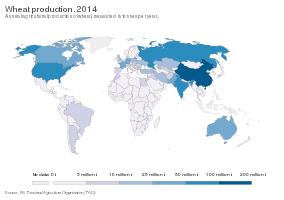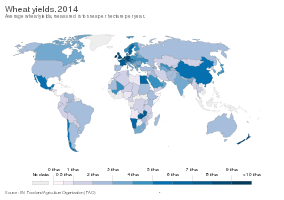Wheat
Wheat is a grass widely cultivated for its seed, a cereal grain which is a worldwide staple food.[2][3][4] The many species of wheat together make up the genus Triticum; the most widely grown is common wheat (T. aestivum). The archaeological record suggests that wheat was first cultivated in the regions of the Fertile Crescent around 9600 BCE. Botanically, the wheat kernel is a type of fruit called a caryopsis.
| Wheat | |
|---|---|
| Scientific classification | |
| Kingdom: | Plantae |
| Clade: | Tracheophytes |
| Clade: | Angiosperms |
| Clade: | Monocots |
| Clade: | Commelinids |
| Order: | Poales |
| Family: | Poaceae |
| Subfamily: | Pooideae |
| Supertribe: | Triticodae |
| Tribe: | Triticeae |
| Genus: | Triticum L. |
| Type species | |
| Triticum aestivum | |
| Species | |
References: | |
Wheat is grown on more land area than any other food crop (220.4 million hectares, 2014).[5] World trade in wheat is greater than for all other crops combined.[6] In 2017, world production of wheat was 772 million tonnes, with a forecast of 2019 production at 766 million tonnes,[7] making it the second most-produced cereal after maize.[7][8] Since 1960, world production of wheat and other grain crops has tripled and is expected to grow further through the middle of the 21st century.[9] Global demand for wheat is increasing due to the unique viscoelastic and adhesive properties of gluten proteins, which facilitate the production of processed foods, whose consumption is increasing as a result of the worldwide industrialization process and the westernization of the diet.[10][11]
Wheat is an important source of carbohydrates.[10] Globally, it is the leading source of vegetable protein in human food, having a protein content of about 13%, which is relatively high compared to other major cereals[12] but relatively low in protein quality for supplying essential amino acids.[13][14] When eaten as the whole grain, wheat is a source of multiple nutrients and dietary fiber.[10]
In a small part of the general population, gluten – the major part of wheat protein – can trigger coeliac disease, noncoeliac gluten sensitivity, gluten ataxia, and dermatitis herpetiformis.[15]
Origin and history
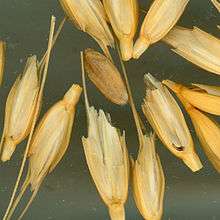
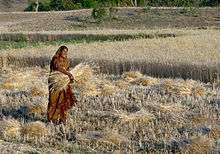
Cultivation and repeated harvesting and sowing of the grains of wild grasses led to the creation of domestic strains, as mutant forms ('sports') of wheat were preferentially chosen by farmers. In domesticated wheat, grains are larger, and the seeds (inside the spikelets) remain attached to the ear by a toughened rachis during harvesting.[16] In wild strains, a more fragile rachis allows the ear to easily shatter and disperse the spikelets.[17] Selection for these traits by farmers might not have been deliberately intended, but simply have occurred because these traits made gathering the seeds easier; nevertheless such 'incidental' selection was an important part of crop domestication. As the traits that improve wheat as a food source also involve the loss of the plant's natural seed dispersal mechanisms, highly domesticated strains of wheat cannot survive in the wild.
Archaeological analysis of wild emmer indicates that it was first cultivated in the southern Levant, with finds dating back as far as 9600 BCE.[18][19] Genetic analysis of wild einkorn wheat suggests that it was first grown in the Karacadag Mountains in southeastern Turkey. Dated archeological remains of einkorn wheat in settlement sites near this region, including those at Abu Hureyra in Syria, suggest the domestication of einkorn near the Karacadag Mountain Range.[20] With the anomalous exception of two grains from Iraq ed-Dubb, the earliest carbon-14 date for einkorn wheat remains at Abu Hureyra is 7800 to 7500 years BCE.[21]
Remains of harvested emmer from several sites near the Karacadag Range have been dated to between 8600 (at Cayonu) and 8400 BCE (Abu Hureyra), that is, in the Neolithic period. With the exception of Iraq ed-Dubb, the earliest carbon-14 dated remains of domesticated emmer wheat were found in the earliest levels of Tell Aswad, in the Damascus basin, near Mount Hermon in Syria. These remains were dated by Willem van Zeist and his assistant Johanna Bakker-Heeres to 8800 BCE. They also concluded that the settlers of Tell Aswad did not develop this form of emmer themselves, but brought the domesticated grains with them from an as yet unidentified location elsewhere.[22]
The cultivation of emmer reached Greece, Cyprus and Indian subcontinent by 6500 BCE, Egypt shortly after 6000 BCE, and Germany and Spain by 5000 BCE.[23] "The early Egyptians were developers of bread and the use of the oven and developed baking into one of the first large-scale food production industries."[24] By 4000 BCE, wheat had reached the British Isles and Scandinavia.[25][26][27] About two millennia later it reached China.
The oldest evidence for hexaploid wheat has been confirmed through DNA analysis of wheat seeds, dating to around 6400-6200 BCE, recovered from Çatalhöyük.[28] The first identifiable bread wheat (Triticum aestivum) with sufficient gluten for yeasted breads has been identified using DNA analysis in samples from a granary dating to approximately 1350 BCE at Assiros in Macedonia.[29]
From Asia, wheat continued to spread across Europe. In the British Isles, wheat straw (thatch) was used for roofing in the Bronze Age, and was in common use until the late 19th century.[30][31]
Farming techniques
Technological advances in soil preparation and seed placement at planting time, use of crop rotation and fertilizers to improve plant growth, and advances in harvesting methods have all combined to promote wheat as a viable crop. When the use of seed drills replaced broadcasting sowing of seed in the 18th century, another great increase in productivity occurred.
Yields of pure wheat per unit area increased as methods of crop rotation were applied to long cultivated land, and the use of fertilizers became widespread. Improved agricultural husbandry has more recently included threshing machines, reaper-binder machines (the 'combine harvester'), tractor-drawn cultivators and planters, and better varieties (see Green Revolution and Norin 10 wheat). Great expansion of wheat production occurred as new arable land was farmed in the Americas and Australia in the 19th and 20th centuries.
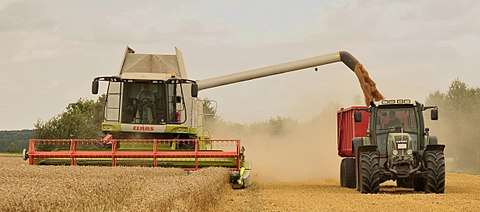 A combine harvester threshes the wheat, crushes the chaff, then blows chaff across the field. The combine loads the threshed wheat onto a trailer while moving
A combine harvester threshes the wheat, crushes the chaff, then blows chaff across the field. The combine loads the threshed wheat onto a trailer while moving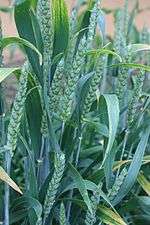 Green wheat a month before harvest
Green wheat a month before harvest Young wheat crop in a field near Solapur, Maharashtra, India
Young wheat crop in a field near Solapur, Maharashtra, India
Physiology
Leaves emerge from the shoot apical meristem in a telescoping fashion until the transition to reproduction ie. flowering.[32] The last leaf produced by a wheat plant is known as the flag leaf. It is denser and has a higher photosynthetic rate than other leaves, to supply carbohydrate to the developing ear. In temperate countries the flag leaf, along with the second and third highest leaf on the plant, supply the majority of carbohydrate in the grain and their condition is paramount to yield formation.[33][34] Wheat is unusual among plants in having more stomata on the upper (adaxial) side of the leaf, than on the under (abaxial) side.[35] It has been theorised that this might be an effect of it having been domesticated and cultivated longer than any other plant.[36] Winter wheat generally produces up to 15 leaves per shoot and spring wheat up to 9[37] and winter crops may have up to 35 tillers (shoots) per plant (depending on cultivar).[37]
Wheat roots are among the deepest of arable crops, extending as far down as 2m.[38] While the roots of a wheat plant are growing, the plant also accumulates an energy store in its stem, in the form of fructans,[39] which helps the plant to yield under drought and disease pressure,[40] but it has been observed that there is a trade-off between root growth and stem non-structural carbohydrate reserves.[41] Root growth is likely to be prioritised in drought-adapted crops, while stem non-structural carbohydrate is prioritised in varieties developed for countries where disease is a bigger issue. Depending on variety, wheat may be awned or not awned. Producing awns incurs a cost in grain number,[42] but wheat awns photosynthesise more water-use-efficiently than their leaves,[43] so awns are much more frequent in varieties of wheat grown in hot drought-prone countries than those generally seen in temperate countries. For this reason, awned varieties could become more widely grown due to climate change. In Europe, however, a decline in climate resilience of wheat has been observed.[44]
Genetics and breeding
In traditional agricultural systems wheat populations often consist of landraces, informal farmer-maintained populations that often maintain high levels of morphological diversity. Although landraces of wheat are no longer grown in Europe and North America, they continue to be important elsewhere. The origins of formal wheat breeding lie in the nineteenth century, when single line varieties were created through selection of seed from a single plant noted to have desired properties. Modern wheat breeding developed in the first years of the twentieth century and was closely linked to the development of Mendelian genetics. The standard method of breeding inbred wheat cultivars is by crossing two lines using hand emasculation, then selfing or inbreeding the progeny. Selections are identified (shown to have the genes responsible for the varietal differences) ten or more generations before release as a variety or cultivar.[45]
Major breeding objectives include high grain yield, good quality, disease and insect resistance and tolerance to abiotic stresses, including mineral, moisture and heat tolerance. The major diseases in temperate environments include the following, arranged in a rough order of their significance from cooler to warmer climates: eyespot, Stagonospora nodorum blotch (also known as glume blotch), yellow or stripe rust, powdery mildew, Septoria tritici blotch (sometimes known as leaf blotch), brown or leaf rust, Fusarium head blight, tan spot and stem rust. In tropical areas, spot blotch (also known as Helminthosporium leaf blight) is also important.
Wheat has also been the subject of mutation breeding, with the use of gamma, x-rays, ultraviolet light, and sometimes harsh chemicals. The varieties of wheat created through these methods are in the hundreds (going as far back as 1960), more of them being created in higher populated countries such as China.[46] Bread wheat with high grain iron and zinc content was developed through gamma radiation breeding.[47]
International wheat breeding is led by CIMMYT in Mexico. ICARDA is another major public sector international wheat breeder, but it was forced to relocate from Syria in the Syrian Civil War.
Yields
The presence of certain versions of wheat genes has been important for crop yields. Genes for the 'dwarfing' trait, first used by Japanese wheat breeders to produce short-stalked wheat, have had a huge effect on wheat yields worldwide, and were major factors in the success of the Green Revolution in Mexico and Asia, an initiative led by Norman Borlaug. Dwarfing genes enable the carbon that is fixed in the plant during photosynthesis to be diverted towards seed production, and they also help prevent the problem of lodging. 'Lodging' occurs when an ear stalk falls over in the wind and rots on the ground, and heavy nitrogenous fertilization of wheat makes the grass grow taller and become more susceptible to this problem. By 1997, 81% of the developing world's wheat area was planted to semi-dwarf wheats, giving both increased yields and better response to nitrogenous fertilizer.
The world record wheat yield is about 17t/ha, reached in New Zealand in 2017.[48] A project in the UK, led by Rothamsted Research has aimed to raise wheat yields in the country to 20t/ha by 2020, but in 2018 the UK record stood at 16t/ha, and the average yield was just 8t/ha.[49][50]
Disease resistance
Wild grasses in the genus Triticum and related genera, and grasses such as rye have been a source of many disease-resistance traits for cultivated wheat breeding since the 1930s.[51]
Hybrid wheats
Because wheat self-pollinates, creating hybrid varieties is extremely labor-intensive; the high cost of hybrid wheat seed relative to its moderate benefits have kept farmers from adopting them widely[52][53] despite nearly 90 years of effort.[54]
F1 hybrid wheat cultivars should not be confused with wheat cultivars deriving from standard plant breeding. Heterosis or hybrid vigor (as in the familiar F1 hybrids of maize) occurs in common (hexaploid) wheat, but it is difficult to produce seed of hybrid cultivars on a commercial scale as is done with maize because wheat flowers are perfect in the botanical sense, meaning they have both male and female parts, and normally self-pollinate.[45] Commercial hybrid wheat seed has been produced using chemical hybridizing agents, plant growth regulators that selectively interfere with pollen development, or naturally occurring cytoplasmic male sterility systems. Hybrid wheat has been a limited commercial success in Europe (particularly France), the United States and South Africa.[55]
Synthetic hexaploids made by crossing the wild goatgrass wheat ancestor Aegilops tauschii and various durum wheats are now being deployed, and these increase the genetic diversity of cultivated wheats.[56][57][58]
Gluten
Modern bread wheat varieties have been cross-bred to contain greater amounts of gluten,[59] which affords significant advantages for improving the quality of breads and pastas from a functional point of view.[60]
Water efficiency
Stomata (or leaf pores) are involved in both uptake of carbon dioxide gas from the atmosphere and water vapor losses from the leaf due to water transpiration. Basic physiological investigation of these gas exchange processes has yielded valuable carbon isotope based methods that are used for breeding wheat varieties with improved water-use efficiency. These varieties can improve crop productivity in rain-fed dry-land wheat farms.[61]
Genome
In 2010, a team of UK scientists funded by BBSRC announced they had decoded the wheat genome for the first time (95% of the genome of a variety of wheat known as Chinese Spring line 42).[62] This genome was released in a basic format for scientists and plant breeders to use but was not a fully annotated sequence which was reported in some of the media.[63] On 29 November 2012, an essentially complete gene set of bread wheat was published.[64] Random shotgun libraries of total DNA and cDNA from the T. aestivum cv. Chinese Spring (CS42) were sequenced in Roche 454 pyrosequencer using GS FLX Titanium and GS FLX+ platforms to generate 85 Gb of sequence (220 million reads) and identified between 94,000 and 96,000 genes.[64] The implications of the research in cereal genetics and breeding includes the examination of genome variation, analysis of population genetics and evolutionary biology, and further studying epigenetic modifications.[65]
Varieties
There are around 30,000 wheat varieties of 14 species grown throughout the world. Of these about 1,000 are commercially significant. In the United States over 500 varieties are available. In Canada different varieties are blended prior to sale. "Identity preserved" wheat that has been stored and transported separately (at extra cost) usually fetches a higher price.[66]
Apart from mutant versions of genes selected in antiquity during domestication, there has been more recent deliberate selection of alleles that affect growth characteristics. Some wheat species are diploid, with two sets of chromosomes, but many are stable polyploids, with four sets of chromosomes (tetraploid) or six (hexaploid).[67]
Einkorn wheat (T. monococcum) is diploid (AA, two complements of seven chromosomes, 2n=14).[4]
Most tetraploid wheats (e.g. emmer and durum wheat) are derived from wild emmer, T. dicoccoides. Wild emmer is itself the result of a hybridization between two diploid wild grasses, T. urartu and a wild goatgrass such as Aegilops searsii or Ae. speltoides. The unknown grass has never been identified among non extinct wild grasses, but the closest living relative is Aegilops speltoides.[68] The hybridization that formed wild emmer (AABB) occurred in the wild, long before domestication,[67] and was driven by natural selection.
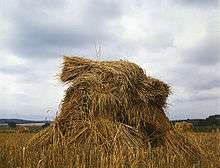
.jpg)
Hexaploid wheats evolved in farmers' fields. Either domesticated emmer or durum wheat hybridized with yet another wild diploid grass (Aegilops tauschii) to make the hexaploid wheats, spelt wheat and bread wheat.[67] These have three sets of paired chromosomes, three times as many as in diploid wheat.
Major cultivated species of wheat
Hexaploid species
- Common wheat or bread wheat (T. aestivum) – A hexaploid species that is the most widely cultivated in the world.
- Spelt (T. spelta) – Another hexaploid species cultivated in limited quantities. Spelt is sometimes considered a subspecies of the closely related species common wheat (T. aestivum), in which case its botanical name is considered to be T. aestivum ssp. spelta.
Tetraploid species
- Durum (T. durum) – A tetraploid form of wheat widely used today, and the second most widely cultivated wheat.
- Emmer (T. dicoccon) – A tetraploid species, cultivated in ancient times but no longer in widespread use.
- Khorasan (T. turgidum ssp. turanicum, also called T. turanicum) is a tetraploid wheat species. It is an ancient grain type; Khorasan refers to a historical region in modern-day Afghanistan and the northeast of Iran. This grain is twice the size of modern-day wheat and is known for its rich nutty flavor.
Diploid species
Hulled versus free-threshing species

The four wild species of wheat, along with the domesticated varieties einkorn,[69] emmer[70] and spelt,[71] have hulls. This more primitive morphology (in evolutionary terms) consists of toughened glumes that tightly enclose the grains, and (in domesticated wheats) a semi-brittle rachis that breaks easily on threshing.
The result is that when threshed, the wheat ear breaks up into spikelets. To obtain the grain, further processing, such as milling or pounding, is needed to remove the hulls or husks. Hulled wheats are often stored as spikelets because the toughened glumes give good protection against pests of stored grain.[69]
In free-threshing (or naked) forms, such as durum wheat and common wheat, the glumes are fragile and the rachis tough. On threshing, the chaff breaks up, releasing the grains.
Naming

_-Osterloh_Nr._138-.jpg)
There are many botanical classification systems used for wheat species, discussed in a separate article on wheat taxonomy. The name of a wheat species from one information source may not be the name of a wheat species in another.
Within a species, wheat cultivars are further classified by wheat breeders and farmers in terms of:
- Growing season, such as winter wheat vs. spring wheat.[72]
- Protein content. Bread wheat protein content ranges from 10% in some soft wheats with high starch contents, to 15% in hard wheats.
- The quality of the wheat protein gluten. This protein can determine the suitability of a wheat to a particular dish. A strong and elastic gluten present in bread wheats enables dough to trap carbon dioxide during leavening, but elastic gluten interferes with the rolling of pasta into thin sheets. The gluten protein in durum wheats used for pasta is strong but not elastic.
- Grain color (red, white or amber). Many wheat varieties are reddish-brown due to phenolic compounds present in the bran layer which are transformed to pigments by browning enzymes. White wheats have a lower content of phenolics and browning enzymes, and are generally less astringent in taste than red wheats. The yellowish color of durum wheat and semolina flour made from it is due to a carotenoid pigment called lutein, which can be oxidized to a colorless form by enzymes present in the grain.
Classes used in North America
The named classes of wheat in English are more or less the same in Canada as in the US, as broadly the same commercial cash crop strains can be found in both.
The classes used in the United States are :[73][74]
- Durum – Very hard, translucent, light-colored grain used to make semolina flour for pasta and bulghur; high in protein, specifically, gluten protein.
- Hard Red Spring – Hard, brownish, high-protein wheat used for bread and hard baked goods. Bread flour and high-gluten flours are commonly made from hard red spring wheat. It is primarily traded on the Minneapolis Grain Exchange.
- Hard Red Winter – Hard, brownish, mellow high-protein wheat used for bread, hard baked goods and as an adjunct in other flours to increase protein in pastry flour for pie crusts. Some brands of unbleached all-purpose flours are commonly made from hard red winter wheat alone. It is primarily traded on the Kansas City Board of Trade. One variety is known as "turkey red wheat", and was brought to Kansas by Mennonite immigrants from Russia.[75]
- Soft Red Winter – Soft, low-protein wheat used for cakes, pie crusts, biscuits, and muffins. Cake flour, pastry flour, and some self-rising flours with baking powder and salt added, for example, are made from soft red winter wheat. It is primarily traded on the Chicago Board of Trade.
- Hard White – Hard, light-colored, opaque, chalky, medium-protein wheat planted in dry, temperate areas. Used for bread and brewing.
- Soft White – Soft, light-colored, very low protein wheat grown in temperate moist areas. Used for pie crusts and pastry. Pastry flour, for example, is sometimes made from soft white winter wheat.
Red wheats may need bleaching; therefore, white wheats usually command higher prices than red wheats on the commodities market.
As a food
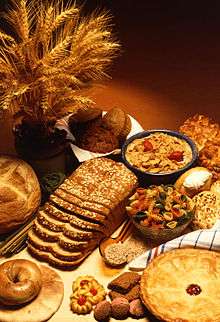
| Nutritional value per 100 g (3.5 oz) | |
|---|---|
| Energy | 1,368 kJ (327 kcal) |
71.18 g | |
| Sugars | 0.41 |
| Dietary fiber | 12.2 g |
1.54 g | |
12.61 g | |
| Vitamins | Quantity %DV† |
| Thiamine (B1) | 33% 0.383 mg |
| Riboflavin (B2) | 10% 0.115 mg |
| Niacin (B3) | 36% 5.464 mg |
| Pantothenic acid (B5) | 19% 0.954 mg |
| Vitamin B6 | 23% 0.3 mg |
| Folate (B9) | 10% 38 μg |
| Choline | 6% 31.2 mg |
| Vitamin E | 7% 1.01 mg |
| Vitamin K | 2% 1.9 μg |
| Minerals | Quantity %DV† |
| Calcium | 3% 29 mg |
| Iron | 25% 3.19 mg |
| Magnesium | 35% 126 mg |
| Manganese | 190% 3.985 mg |
| Phosphorus | 41% 288 mg |
| Potassium | 8% 363 mg |
| Sodium | 0% 2 mg |
| Zinc | 28% 2.65 mg |
| Other constituents | Quantity |
| Water | 13.1 g |
| Selenium | 70.7 µg |
| |
| †Percentages are roughly approximated using US recommendations for adults. Source: USDA Nutrient Database | |
Raw wheat can be ground into flour or, using hard durum wheat only, can be ground into semolina; germinated and dried creating malt; crushed or cut into cracked wheat; parboiled (or steamed), dried, crushed and de-branned into bulgur also known as groats. If the raw wheat is broken into parts at the mill, as is usually done, the outer husk or bran can be used several ways
Wheat is a major ingredient in such foods as bread, porridge, crackers, biscuits, muesli, pancakes, pasta and noodles, pies, pastries, pizza, polenta and semolina, cakes, cookies, muffins, rolls, doughnuts, gravy, beer, vodka, boza (a fermented beverage), and breakfast cereals.[76]
In manufacturing wheat products, gluten is valuable to impart viscoelastic functional qualities in dough,[77] enabling the preparation of diverse processed foods such as breads, noodles, and pasta that facilitate wheat consumption.[78][10]
Nutrition
In 100 grams, wheat provides 1,370 kilojoules (327 kilocalories) of food energy and is a rich source (20% or more of the Daily Value, DV) of multiple essential nutrients, such as protein, dietary fiber, manganese, phosphorus and niacin (table). Several B vitamins and other dietary minerals are in significant content. Wheat is 13% water, 71% carbohydrates, and 1.5% fat. Its 13% protein content is mostly gluten (75-80% of the protein in wheat).[77]
Wheat proteins have a low quality for human nutrition, according to the new protein quality method (DIAAS) promoted by the Food and Agriculture Organization.[14][79] Though they contain adequate amounts of the other essential amino acids, at least for adults, wheat proteins are deficient in the essential amino acid, lysine.[10][80] Because the proteins present in the wheat endosperm (gluten proteins) are particularly poor in lysine, white flours are more deficient in lysine compared with whole grains.[10] Significant efforts in plant breeding are being made to develop lysine-rich wheat varieties, without success as of 2017.[81] Supplementation with proteins from other food sources (mainly legumes) is commonly used to compensate for this deficiency,[13] since the limitation of a single essential amino acid causes the others to break down and become excreted, which is especially important during the period of growth.[10]
| Protein | Fiber | Vitamins | Minerals | |||||||||||||||||||||||
|---|---|---|---|---|---|---|---|---|---|---|---|---|---|---|---|---|---|---|---|---|---|---|---|---|---|---|
| Food | DV | Q | DV | A | B1 | B2 | B3 | B5 | B6 | B9 | B12 | Ch. | C | D | E | K | Ca | Fe | Mg | P | K | Na | Zn | Cu | Mn | Se |
| cooking Reduction % | 10 | 30 | 20 | 25 | 25 | 35 | 0 | 0 | 30 | 10 | 15 | 20 | 10 | 20 | 5 | 10 | 25 | |||||||||
| Corn | 20 | 55 | 6 | 1 | 13 | 4 | 16 | 4 | 19 | 19 | 0 | 0 | 0 | 0 | 0 | 1 | 1 | 11 | 31 | 34 | 15 | 1 | 20 | 10 | 42 | 0 |
| Rice | 14 | 71 | 1.3 | 0 | 12 | 3 | 11 | 20 | 5 | 2 | 0 | 0 | 0 | 0 | 0 | 0 | 1 | 9 | 6 | 7 | 2 | 0 | 8 | 9 | 49 | 22 |
| Wheat | 27 | 51 | 40 | 0 | 28 | 7 | 34 | 19 | 21 | 11 | 0 | 0 | 0 | 0 | 0 | 0 | 3 | 20 | 36 | 51 | 12 | 0 | 28 | 28 | 151 | 128 |
| Soybean(dry) | 73 | 132 | 31 | 0 | 58 | 51 | 8 | 8 | 19 | 94 | 0 | 24 | 10 | 0 | 4 | 59 | 28 | 87 | 70 | 70 | 51 | 0 | 33 | 83 | 126 | 25 |
| Pigeon pea(dry) | 42 | 91 | 50 | 1 | 43 | 11 | 15 | 13 | 13 | 114 | 0 | 0 | 0 | 0 | 0 | 0 | 13 | 29 | 46 | 37 | 40 | 1 | 18 | 53 | 90 | 12 |
| Potato | 4 | 112 | 7.3 | 0 | 5 | 2 | 5 | 3 | 15 | 4 | 0 | 0 | 33 | 0 | 0 | 2 | 1 | 4 | 6 | 6 | 12 | 0 | 2 | 5 | 8 | 0 |
| Sweet potato | 3 | 82 | 10 | 284 | 5 | 4 | 3 | 8 | 10 | 3 | 0 | 0 | 4 | 0 | 1 | 2 | 3 | 3 | 6 | 5 | 10 | 2 | 2 | 8 | 13 | 1 |
| Spinach | 6 | 119 | 7.3 | 188 | 5 | 11 | 4 | 1 | 10 | 49 | 0 | 4.5 | 47 | 0 | 10 | 604 | 10 | 15 | 20 | 5 | 16 | 3 | 4 | 6 | 45 | 1 |
| Dill | 7 | 32 | 7 | 154 | 4 | 17 | 8 | 4 | 9 | 38 | 0 | 0 | 142 | 0 | 0 | 0 | 21 | 37 | 14 | 7 | 21 | 3 | 6 | 7 | 63 | 0 |
| Carrots | 2 | 9.3 | 334 | 4 | 3 | 5 | 3 | 7 | 5 | 0 | 0 | 10 | 0 | 3 | 16 | 3 | 2 | 3 | 4 | 9 | 3 | 2 | 2 | 7 | 0 | |
| Guava | 5 | 24 | 18 | 12 | 4 | 2 | 5 | 5 | 6 | 12 | 0 | 0 | 381 | 0 | 4 | 3 | 2 | 1 | 5 | 4 | 12 | 0 | 2 | 11 | 8 | 1 |
| Papaya | 1 | 7 | 5.6 | 22 | 2 | 2 | 2 | 2 | 1 | 10 | 0 | 0 | 103 | 0 | 4 | 3 | 2 | 1 | 2 | 1 | 7 | 0 | 0 | 1 | 1 | 1 |
| Pumpkin | 2 | 56 | 1.6 | 184 | 3 | 6 | 3 | 3 | 3 | 4 | 0 | 0 | 15 | 0 | 5 | 1 | 2 | 4 | 3 | 4 | 10 | 0 | 2 | 6 | 6 | 0 |
| Sunflower oil | 0 | 0 | 0 | 0 | 0 | 0 | 0 | 0 | 0 | 0 | 0 | 0 | 0 | 205 | 7 | 0 | 0 | 0 | 0 | 0 | 0 | 0 | 0 | 0 | 0 | |
| Egg | 25 | 136 | 0 | 10 | 5 | 28 | 0 | 14 | 7 | 12 | 22 | 45 | 0 | 9 | 5 | 0 | 5 | 10 | 3 | 19 | 4 | 6 | 7 | 5 | 2 | 45 |
| Milk | 6 | 138 | 0 | 2 | 3 | 11 | 1 | 4 | 2 | 1 | 7 | 2.6 | 0 | 0 | 0 | 0 | 11 | 0 | 2 | 9 | 4 | 2 | 3 | 1 | 0 | 5 |
| Chicken Liver | 34 | 149 | 0 | 222 | 20 | 105 | 49 | 62 | 43 | 147 | 276 | 30 | 0 | 4 | 0 | 1 | 50 | 5 | 30 | 7 | 3 | 18 | 25 | 13 | 78 | |
| %DV = % daily value i.e. % of DRI (Dietary Reference Intake)
Note: All nutrient values including protein and fiber are in %DV per 100 grams of the food item. Significant values are highlighted in light Gray color and bold letters. [82][83] Cooking reduction = % Maximum typical reduction in nutrients due to boiling without draining for ovo-lacto-vegetables group[84][85] Q = Quality of Protein in terms of completeness without adjusting for digestability.[85] | ||||||||||||||||||||||||||
100 g (3.5 oz) of hard red winter wheat contain about 12.6 g (0.44 oz) of protein, 1.5 g (0.053 oz) of total fat, 71 g (2.5 oz) of carbohydrate (by difference), 12.2 g (0.43 oz) of dietary fiber, and 3.2 mg (0.00011 oz) of iron (17% of the daily requirement); the same weight of hard red spring wheat contains about 15.4 g (0.54 oz) of protein, 1.9 g (0.067 oz) of total fat, 68 g (2.4 oz) of carbohydrate (by difference), 12.2 g (0.43 oz) of dietary fiber, and 3.6 mg (0.00013 oz) of iron (20% of the daily requirement).[86]
Worldwide production
Wheat is grown on more than 218,000,000 hectares (540,000,000 acres).[87]
The most common forms of wheat are white and red wheat. However, other natural forms of wheat exist. Other commercially minor but nutritionally promising species of naturally evolved wheat species include black, yellow and blue wheat.[6][88][89]
Health effects
Consumed worldwide by billions of people, wheat is a significant food for human nutrition, particularly in the least developed countries where wheat products are primary foods.[2][10] When eaten as the whole grain, wheat is a healthy food source of multiple nutrients and dietary fiber recommended for children and adults, in several daily servings containing a variety of foods that meet whole grain-rich criteria.[10][78][90][91] Dietary fiber may also help people feel full and therefore help with a healthy weight.[92] Further, wheat is a major source for natural and biofortified nutrient supplementation, including dietary fiber, protein and dietary minerals.[93]
Manufacturers of foods containing wheat as a whole grain in specified amounts are allowed a health claim for marketing purposes in the United States, stating: "low fat diets rich in fiber-containing grain products, fruits, and vegetables may reduce the risk of some types of cancer, a disease associated with many factors" and "diets low in saturated fat and cholesterol and rich in fruits, vegetables, and grain products that contain some types of dietary fiber, particularly soluble fiber, may reduce the risk of heart disease, a disease associated with many factors".[94][95] The scientific opinion of the European Food Safety Authority (EFSA) related to health claims on gut health/bowel function, weight control, blood glucose/insulin levels, weight management, blood cholesterol, satiety, glycaemic index, digestive function and cardiovascular health is "that the food constituent, whole grain, (...) is not sufficiently characterised in relation to the claimed health effects" and "that a cause and effect relationship cannot be established between the consumption of whole grain and the claimed effects considered in this opinion."[78][96]
Concerns
In genetically susceptible people, gluten – a major part of wheat protein – can trigger coeliac disease.[77][97] Coeliac disease affects about 1% of the general population in developed countries.[98][97] There is evidence that most cases remain undiagnosed and untreated.[97] The only known effective treatment is a strict lifelong gluten-free diet.[97]
While coeliac disease is caused by a reaction to wheat proteins, it is not the same as a wheat allergy.[98][97] Other diseases triggered by eating wheat are non-coeliac gluten sensitivity[98][15] (estimated to affect 0.5% to 13% of the general population[99]), gluten ataxia, and dermatitis herpetiformis.[15]
It has been speculated that FODMAPs present in wheat (mainly fructans) are the cause of non-coeliac gluten sensitivity. As of 2019, reviews have concluded that FODMAPs only explain certain gastrointestinal symptoms, such as bloating, but not the extra-digestive symptoms that people with non-coeliac gluten sensitivity may develop, such as neurological disorders, fibromyalgia, psychological disturbances, and dermatitis.[100][101][102]
Other proteins present in wheat called amylase-trypsin inhibitors (ATIs) have been identified as the possible activator of the innate immune system in coeliac disease and non-coeliac gluten sensitivity.[102][101] ATIs are part of the plant's natural defense against insects and may cause toll-like receptor 4 (TLR4)-mediated intestinal inflammation in humans.[101][103][104] These TLR4-stimulating activities of ATIs are limited to gluten-containing cereals.[102] A 2017 study in mice demonstrated that ATIs exacerbate preexisting inflammation and might also worsen it at extraintestinal sites. This may explain why there is an increase of inflammation in people with preexisting diseases upon ingestion of ATIs-containing grains.[101]
Comparison with other staple foods
The following table shows the nutrient content of wheat and other major staple foods in a raw form.[105]
Raw forms of these staples, however, are not edible and cannot be digested. These must be sprouted, or prepared and cooked as appropriate for human consumption. In sprouted or cooked form, the relative nutritional and anti-nutritional contents of each of these grains is remarkably different from that of raw form of these grains reported in this table.
In cooked form, the nutrition value for each staple depends on the cooking method (for example: baking, boiling, steaming, frying, etc.).
| Nutrient | Maize (corn)[A] | Rice, white[B] | Wheat[C] | Potatoes[D] | Cassava[E] | Soybeans, green[F] | Sweet potatoes[G] | Yams[Y] | Sorghum[H] | Plantain[Z] | RDA |
|---|---|---|---|---|---|---|---|---|---|---|---|
| Water (g) | 10 | 12 | 13 | 79 | 60 | 68 | 77 | 70 | 9 | 65 | 3,000 |
| Energy (kJ) | 1,528 | 1,528 | 1,369 | 322 | 670 | 615 | 360 | 494 | 1,419 | 511 | 8,368–10,460 |
| Protein (g) | 9.4 | 7.1 | 12.6 | 2.0 | 1.4 | 13.0 | 1.6 | 1.5 | 11.3 | 1.3 | 50 |
| Fat (g) | 4.74 | 0.66 | 1.54 | 0.09 | 0.28 | 6.8 | 0.05 | 0.17 | 3.3 | 0.37 | 44–77 |
| Carbohydrates (g) | 74 | 80 | 71 | 17 | 38 | 11 | 20 | 28 | 75 | 32 | 130 |
| Fiber (g) | 7.3 | 1.3 | 12.2 | 2.2 | 1.8 | 4.2 | 3 | 4.1 | 6.3 | 2.3 | 30 |
| Sugar (g) | 0.64 | 0.12 | 0.41 | 0.78 | 1.7 | 0 | 4.18 | 0.5 | 0 | 15 | minimal |
| Minerals | [A] | [B] | [C] | [D] | [E] | [F] | [G] | [Y] | [H] | [Z] | RDA |
| Calcium (mg) | 7 | 28 | 29 | 12 | 16 | 197 | 30 | 17 | 28 | 3 | 1,000 |
| Iron (mg) | 2.71 | 0.8 | 3.19 | 0.78 | 0.27 | 3.55 | 0.61 | 0.54 | 4.4 | 0.6 | 8 |
| Magnesium (mg) | 127 | 25 | 126 | 23 | 21 | 65 | 25 | 21 | 0 | 37 | 400 |
| Phosphorus (mg) | 210 | 115 | 288 | 57 | 27 | 194 | 47 | 55 | 287 | 34 | 700 |
| Potassium (mg) | 287 | 115 | 363 | 421 | 271 | 620 | 337 | 816 | 350 | 499 | 4,700 |
| Sodium (mg) | 35 | 5 | 2 | 6 | 14 | 15 | 55 | 9 | 6 | 4 | 1,500 |
| Zinc (mg) | 2.21 | 1.09 | 2.65 | 0.29 | 0.34 | 0.99 | 0.3 | 0.24 | 0 | 0.14 | 11 |
| Copper (mg) | 0.31 | 0.22 | 0.43 | 0.11 | 0.10 | 0.13 | 0.15 | 0.18 | - | 0.08 | 0.9 |
| Manganese (mg) | 0.49 | 1.09 | 3.99 | 0.15 | 0.38 | 0.55 | 0.26 | 0.40 | - | - | 2.3 |
| Selenium (μg) | 15.5 | 15.1 | 70.7 | 0.3 | 0.7 | 1.5 | 0.6 | 0.7 | 0 | 1.5 | 55 |
| Vitamins | [A] | [B] | [C] | [D] | [E] | [F] | [G] | [Y] | [H] | [Z] | RDA |
| Vitamin C (mg) | 0 | 0 | 0 | 19.7 | 20.6 | 29 | 2.4 | 17.1 | 0 | 18.4 | 90 |
| Thiamin (B1) (mg) | 0.39 | 0.07 | 0.30 | 0.08 | 0.09 | 0.44 | 0.08 | 0.11 | 0.24 | 0.05 | 1.2 |
| Riboflavin (B2) (mg) | 0.20 | 0.05 | 0.12 | 0.03 | 0.05 | 0.18 | 0.06 | 0.03 | 0.14 | 0.05 | 1.3 |
| Niacin (B3) (mg) | 3.63 | 1.6 | 5.46 | 1.05 | 0.85 | 1.65 | 0.56 | 0.55 | 2.93 | 0.69 | 16 |
| Pantothenic acid (B5) (mg) | 0.42 | 1.01 | 0.95 | 0.30 | 0.11 | 0.15 | 0.80 | 0.31 | - | 0.26 | 5 |
| Vitamin B6 (mg) | 0.62 | 0.16 | 0.3 | 0.30 | 0.09 | 0.07 | 0.21 | 0.29 | - | 0.30 | 1.3 |
| Folate Total (B9) (μg) | 19 | 8 | 38 | 16 | 27 | 165 | 11 | 23 | 0 | 22 | 400 |
| Vitamin A (IU) | 214 | 0 | 9 | 2 | 13 | 180 | 14,187 | 138 | 0 | 1,127 | 5,000 |
| Vitamin E, alpha-tocopherol (mg) | 0.49 | 0.11 | 1.01 | 0.01 | 0.19 | 0 | 0.26 | 0.39 | 0 | 0.14 | 15 |
| Vitamin K1 (μg) | 0.3 | 0.1 | 1.9 | 1.9 | 1.9 | 0 | 1.8 | 2.6 | 0 | 0.7 | 120 |
| Beta-carotene (μg) | 97 | 0 | 5 | 1 | 8 | 0 | 8,509 | 83 | 0 | 457 | 10,500 |
| Lutein+zeaxanthin (μg) | 1,355 | 0 | 220 | 8 | 0 | 0 | 0 | 0 | 0 | 30 | 6,000 |
| Fats | [A] | [B] | [C] | [D] | [E] | [F] | [G] | [Y] | [H] | [Z] | RDA |
| Saturated fatty acids (g) | 0.67 | 0.18 | 0.26 | 0.03 | 0.07 | 0.79 | 0.02 | 0.04 | 0.46 | 0.14 | minimal |
| Monounsaturated fatty acids (g) | 1.25 | 0.21 | 0.2 | 0.00 | 0.08 | 1.28 | 0.00 | 0.01 | 0.99 | 0.03 | 22–55 |
| Polyunsaturated fatty acids (g) | 2.16 | 0.18 | 0.63 | 0.04 | 0.05 | 3.20 | 0.01 | 0.08 | 1.37 | 0.07 | 13–19 |
| [A] | [B] | [C] | [D] | [E] | [F] | [G] | [Y] | [H] | [Z] | RDA |
Commercial use
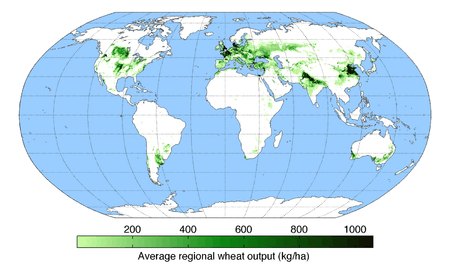
Harvested wheat grain that enters trade is classified according to grain properties for the purposes of the commodity markets. Wheat buyers use these to decide which wheat to buy, as each class has special uses, and producers use them to decide which classes of wheat will be most profitable to cultivate.
Wheat is widely cultivated as a cash crop because it produces a good yield per unit area, grows well in a temperate climate even with a moderately short growing season, and yields a versatile, high-quality flour that is widely used in baking. Most breads are made with wheat flour, including many breads named for the other grains they contain, for example, most rye and oat breads. The popularity of foods made from wheat flour creates a large demand for the grain, even in economies with significant food surpluses.
In recent years, low international wheat prices have often encouraged farmers in the United States to change to more profitable crops. In 1998, the price at harvest of a 60 pounds (27 kg) bushel[107] was $2.68 per.[108] Some information providers, following CBOT practice, quote the wheat market in per ton denomination.[109] A USDA report revealed that in 1998, average operating costs were $1.43 per bushel and total costs were $3.97 per bushel.[108] In that study, farm wheat yields averaged 41.7 bushels per acre (2.2435 metric ton/hectare), and typical total wheat production value was $31,900 per farm, with total farm production value (including other crops) of $173,681 per farm, plus $17,402 in government payments. There were significant profitability differences between low- and high-cost farms, due to crop yield differences, location, and farm size.
Production and consumption
| Country | millions of tonnes | ||||
|---|---|---|---|---|---|
| 134.3 | |||||
| 98.5 | |||||
| 85.9 | |||||
| 47.4 | |||||
| 36.9 | |||||
| World | 772 | ||||
| Source: UN Food and Agriculture Organization[112] | |||||
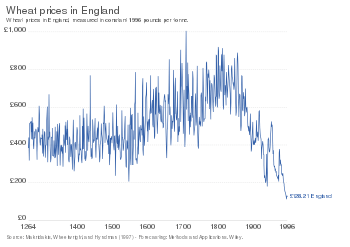
In 2017, global wheat production was 772 million tonnes, led by China, India, and Russia, collectively providing 41% of the world total.[112]
Historical factors
In the 20th century, global wheat output expanded by about 5-fold, but until about 1955 most of this reflected increases in wheat crop area, with lesser (about 20%) increases in crop yields per unit area. After 1955 however, there was a ten-fold increase in the rate of wheat yield improvement per year, and this became the major factor allowing global wheat production to increase. Thus technological innovation and scientific crop management with synthetic nitrogen fertilizer, irrigation and wheat breeding were the main drivers of wheat output growth in the second half of the century. There were some significant decreases in wheat crop area, for instance in North America.[114]
Better seed storage and germination ability (and hence a smaller requirement to retain harvested crop for next year's seed) is another 20th-century technological innovation. In Medieval England, farmers saved one-quarter of their wheat harvest as seed for the next crop, leaving only three-quarters for food and feed consumption. By 1999, the global average seed use of wheat was about 6% of output.
Several factors are currently slowing the rate of global expansion of wheat production: population growth rates are falling while wheat yields continue to rise. There is evidence, however, that rising temperatures associated with climate change are reducing wheat yield in several locations.[115] In addition, the better economic profitability of other crops such as soybeans and maize, linked with investment in modern genetic technologies, has promoted shifts to other crops.
Farming systems
In 2014, the most productive crop yields for wheat were in Ireland, producing 10 tonnes per hectare.[8] In addition to gaps in farming system technology and knowledge, some large wheat grain-producing countries have significant losses after harvest at the farm and because of poor roads, inadequate storage technologies, inefficient supply chains and farmers' inability to bring the produce into retail markets dominated by small shopkeepers. Various studies in India, for example, have concluded that about 10% of total wheat production is lost at farm level, another 10% is lost because of poor storage and road networks, and additional amounts lost at the retail level.[116]
In the Punjab region of the Indian subcontinent, as well as North China, irrigation has been a major contributor to increased grain output. More widely over the last 40 years, a massive increase in fertilizer use together with the increased availability of semi-dwarf varieties in developing countries, has greatly increased yields per hectare.[9] In developing countries, use of (mainly nitrogenous) fertilizer increased 25-fold in this period. However, farming systems rely on much more than fertilizer and breeding to improve productivity. A good illustration of this is Australian wheat growing in the southern winter cropping zone, where, despite low rainfall (300 mm), wheat cropping is successful even with relatively little use of nitrogenous fertilizer. This is achieved by 'rotation cropping' (traditionally called the ley system) with leguminous pastures and, in the last decade, including a canola crop in the rotations has boosted wheat yields by a further 25%.[117] In these low rainfall areas, better use of available soil-water (and better control of soil erosion) is achieved by retaining the stubble after harvesting and by minimizing tillage.[118]
Geographical variation
There are substantial differences in wheat farming, trading, policy, sector growth, and wheat uses in different regions of the world.[7] The largest exporters of wheat in 2016 were, in order of exported quantities: Russian Federation (25.3 million tonnes), United States (24.0 million tonnes), Canada (19.7 million tonnes), France (18.3 million tonnes), and the Australia (16.1 million tonnes).[119] The largest importers of wheat in 2016 were, in order of imported quantities: Indonesia (10.5 million tonnes), Egypt (8.7 million tonnes), Algeria (8.2 million tonnes), Italy (7.7 million tonnes) and Spain (7.0 million tonnes).[119]
In the rapidly developing countries of Asia and Africa, westernization of diets associated with increasing prosperity is leading to growth in per capita demand for wheat at the expense of the other food staples.[7][9]
Most productive
The average annual world farm yield for wheat in 2014 was 3.3 tonnes per hectare (330 grams per square meter).[8] Ireland wheat farms were the most productive in 2014, with a nationwide average of 10.0 tonnes per hectare, followed by the Netherlands (9.2), and Germany, New Zealand and the United Kingdom (each with 8.6).[8]
Futures contracts
Wheat futures are traded on the Chicago Board of Trade, Kansas City Board of Trade, and Minneapolis Grain Exchange, and have delivery dates in March (H), May (K), July (N), September (U), and December (Z).[120]
Agronomy
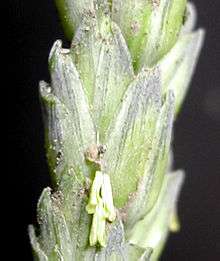
Crop development
Wheat normally needs between 110 and 130 days between sowing and harvest, depending upon climate, seed type, and soil conditions (winter wheat lies dormant during a winter freeze). Optimal crop management requires that the farmer have a detailed understanding of each stage of development in the growing plants. In particular, spring fertilizers, herbicides, fungicides, and growth regulators are typically applied only at specific stages of plant development. For example, it is currently recommended that the second application of nitrogen is best done when the ear (not visible at this stage) is about 1 cm in size (Z31 on Zadoks scale). Knowledge of stages is also important to identify periods of higher risk from the climate. For example, pollen formation from the mother cell, and the stages between anthesis and maturity, are susceptible to high temperatures, and this adverse effect is made worse by water stress.[121] Farmers also benefit from knowing when the 'flag leaf' (last leaf) appears, as this leaf represents about 75% of photosynthesis reactions during the grain filling period, and so should be preserved from disease or insect attacks to ensure a good yield.
Several systems exist to identify crop stages, with the Feekes and Zadoks scales being the most widely used. Each scale is a standard system which describes successive stages reached by the crop during the agricultural season.
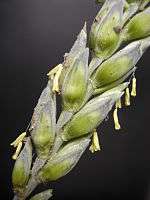

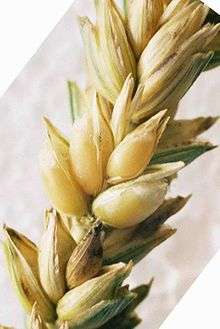
Diseases
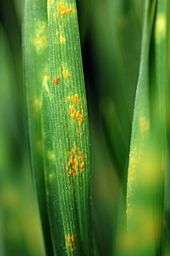
There are many wheat diseases, mainly caused by fungi, bacteria, and viruses.[122] Plant breeding to develop new disease-resistant varieties, and sound crop management practices are important for preventing disease. Fungicides, used to prevent the significant crop losses from fungal disease, can be a significant variable cost in wheat production. Estimates of the amount of wheat production lost owing to plant diseases vary between 10–25% in Missouri.[123] A wide range of organisms infect wheat, of which the most important are viruses and fungi.[124]
The main wheat-disease categories are:
- Seed-borne diseases: these include seed-borne scab, seed-borne Stagonospora (previously known as Septoria), common bunt (stinking smut), and loose smut. These are managed with fungicides.
- Leaf- and head- blight diseases: Powdery mildew, leaf rust, Septoria tritici leaf blotch, Stagonospora (Septoria) nodorum leaf and glume blotch, and Fusarium head scab.[125]
- Crown and root rot diseases: Two of the more important of these are 'take-all' and Cephalosporium stripe. Both of these diseases are soil borne.
- Stem rust diseases: Caused by basidiomycete fungi e.g. Ug99
- Viral diseases: Wheat spindle streak mosaic (yellow mosaic) and barley yellow dwarf are the two most common viral diseases. Control can be achieved by using resistant varieties.
Pests
Wheat is used as a food plant by the larvae of some Lepidoptera (butterfly and moth) species including the flame, rustic shoulder-knot, setaceous Hebrew character and turnip moth. Early in the season, many species of birds, including the long-tailed widowbird, and rodents feed upon wheat crops. These animals can cause significant damage to a crop by digging up and eating newly planted seeds or young plants. They can also damage the crop late in the season by eating the grain from the mature spike. Recent post-harvest losses in cereals amount to billions of dollars per year in the United States alone, and damage to wheat by various borers, beetles and weevils is no exception.[126] Rodents can also cause major losses during storage, and in major grain growing regions, field mice numbers can sometimes build up explosively to plague proportions because of the ready availability of food.[127] To reduce the amount of wheat lost to post-harvest pests, Agricultural Research Service scientists have developed an "insect-o-graph," which can detect insects in wheat that are not visible to the naked eye. The device uses electrical signals to detect the insects as the wheat is being milled. The new technology is so precise that it can detect 5–10 infested seeds out of 300,000 good ones.[128] Tracking insect infestations in stored grain is critical for food safety as well as for the marketing value of the crop.
See also
References
- lectotype designated by Duistermaat, Blumea 32: 174 (1987)
- Shewry, Peter R (2009), "Wheat", Journal of Experimental Botany, 60 (6): 1537–53, doi:10.1093/jxb/erp058, PMID 19386614
- James D. Mauseth (2014). Botany. Jones & Bartlett Publishers. p. 223. ISBN 978-1-4496-4884-8.
Perhaps the simplest of fruits are those of grasses (all cereals such as corn and wheat)...These fruits are caryopses.
- Belderok, Robert 'Bob'; Mesdag, Hans; Donner, Dingena A (2000), Bread-Making Quality of Wheat, Springer, p. 3, ISBN 978-0-7923-6383-5
- "Crops/World Total/Wheat/Area Harvested/2014 (pick list)". United Nations, Food and Agriculture Organization, Statistics Division (FAOSTAT). 2014. Archived from the original on 6 September 2015. Retrieved 8 December 2016.
- Curtis; Rajaraman; MacPherson (2002). "Bread Wheat". Food and Agriculture Organization of the United Nations.
- "World food situation: FAO cereal supply and demand brief". Rome, Italy: United Nations, Food and Agriculture Organization. 10 March 2019. Retrieved 14 December 2016.
- "Crops/World Total/Wheat/Production Quantity/2014 (pick list)". United Nations, Food and Agriculture Organization, Statistics Division (FAOSTAT). 2014. Archived from the original on 6 September 2015. Retrieved 8 December 2016.
- Godfray, H.C.; Beddington, J. R.; Crute, I. R.; Haddad, L; Lawrence, D; Muir, J. F.; Pretty, J; Robinson, S; Thomas, S. M.; Toulmin, C (2010). "Food security: The challenge of feeding 9 billion people". Science. 327 (5967): 812–8. Bibcode:2010Sci...327..812G. doi:10.1126/science.1185383. PMID 20110467.
- Shewry PR, Hey SJ (2015). "Review: The contribution of wheat to human diet and health". Food and Energy Security. 4 (3): 178–202. doi:10.1002/fes3.64. PMC 4998136. PMID 27610232.CS1 maint: uses authors parameter (link)
- Day L, Augustin MA, Batey IL, Wrigley CW (2006). "Wheat-gluten uses and industry needs". Trends in Food Science & Technology (Review). 17 (2): 82–90. doi:10.1016/j.tifs.2005.10.003.
- European Community, Community Research and Development Information Service (CORDIS) (24 February 2016). "Genetic markers signal increased crop productivity potential". Retrieved 1 June 2017.
- "Nutritional quality of cereals". Food and Agriculture Organization of the United Nations. Retrieved 1 June 2017.
- Dietary protein quality evaluation in human nutrition (PDF). Food and Agriculture Organization of the United Nations. 2013. ISBN 978-92-5-107417-6. Retrieved 1 June 2017.
- Ludvigsson JF, Leffler DA, Bai JC, Biagi F, Fasano A, Green PH, Hadjivassiliou M, Kaukinen K, Kelly CP, Leonard JN, Lundin KE, Murray JA, Sanders DS, Walker MM, Zingone F, Ciacci C (January 2013). "The Oslo definitions for coeliac disease and related terms". Gut. 62 (1): 43–52. doi:10.1136/gutjnl-2011-301346. PMC 3440559. PMID 22345659.
- Hughes, N; Oliveira, HR; Fradgley, N; Corke, F; Cockram, J; Doonan, JH; Nibau, C (14 March 2019). "μCT trait analysis reveals morphometric differences between domesticated temperate small grain cereals and their wild relatives". The Plant Journal. 99 (1): 98–111. doi:10.1111/tpj.14312. PMC 6618119. PMID 30868647.
- Tanno, K Willcox; Willcox, G (2006). "How fast was wild wheat domesticated?". Science. 311 (5769): 1886. doi:10.1126/science.1124635. PMID 16574859.
- "Feldman, Moshe and Kislev, Mordechai E., Israel Journal of Plant Sciences, Volume 55, Number 3–4 / 2007, pp. 207–21, Domestication of emmer wheat and evolution of free-threshing tetraploid wheat in "A Century of Wheat Research-From Wild Emmer Discovery to Genome Analysis", Published Online: 3 November 2008". Archived from the original on 6 December 2013. Retrieved 6 July 2011.
- Colledge, Sue; University College, London. Institute of Archaeology (2007). The origins and spread of domestic plants in southwest Asia and Europe. Left Coast Press. pp. 40–. ISBN 978-1-59874-988-5. Retrieved 5 July 2011.
- C. Michael Hogan. 2013. Wheat. Encyclopedia of Earth. National Council of Science and the Environment. Archived 3 December 2013 at the Wayback Machine ed. Lakhdar Boukerrou
- Heun, MR; et al. (1997). "Site of Einkorn Wheat Domestication Identified by DNA Fingerprinting". Science. 278 (5341): 1312–14. Bibcode:1997Sci...278.1312H. doi:10.1126/science.278.5341.1312.
- Ozkan, H; Brandolini, A; Schäfer-Pregl, R; Salamini, F (October 2002). "AFLP analysis of a collection of tetraploid wheats indicates the origin of emmer and hard wheat domestication in southeast Turkey". Molecular Biology and Evolution. 19 (10): 1797–801. doi:10.1093/oxfordjournals.molbev.a004002. PMID 12270906.
- Jared Diamond (1997), Guns, Germs and Steel: A short history of everybody for the last 13,000 years, Viking UK Random House (ISBN 0-09-930278-0).
- Direct quotation: Grundas ST: Chapter: Wheat: The Crop, in Encyclopedia of Food Sciences and Nutrition p. 6130, 2003; Elsevier Science Ltd
- Piotrowski, Jan (26 February 2019). "Britons may have imported wheat long before farming it". New Scientist. Retrieved 4 June 2020.
- Smith, Oliver; Momber, Garry; et al. (2015). "Sedimentary DNA from a submerged site reveals wheat in the British Isles 8000 years ago". Science. 347 (6225): 998–1001. doi:10.1126/science.1261278. hdl:10454/9405. ISSN 0036-8075.
- Brace, Selina; Diekmann, Yoan; et al. (2019). "Ancient genomes indicate population replacement in Early Neolithic Britain". Nature Ecology & Evolution. 3 (5): 765–771. doi:10.1038/s41559-019-0871-9. ISSN 2397-334X.
Neolithic cultures first appear in Britain circa 4000 bc, a millennium after they appeared in adjacent areas of continental Europe.
- Bilgic, Hatice; et al. (2016). "Ancient DNA from 8400 Year-Old Çatalhöyük Wheat: Implications for the Origin of Neolithic Agricultur". PLoS ONE. 11 (3): e0151974. Bibcode:2016PLoSO..1151974B. doi:10.1371/journal.pone.0151974. PMC 4801371. PMID 26998604.
- "The science in detail – Wheats DNA – Research – Archaeology – The University of Sheffield". Sheffield.ac.uk. 19 July 2011. Retrieved 27 May 2012.
- Belderok B et al. (2000) Bread-Making Quality of Wheat Springer p. 3 ISBN 0-7923-6383-3
- Cauvain SP, Cauvain P (2003) Bread Making CRC Press p. 540 ISBN 1-85573-553-9
- Fertilising for High Yield and Quality - Cereals
- Pajević, Slobodanka; Krstić, Borivoj; Stanković, Živko; Plesničar, Marijana; Denčić, Srbislav (1999). "Photosynthesis of Flag and Second Wheat Leaves During Senescence". Cereal Research Communications. 27 (1/2): 155–162. doi:10.1007/BF03543932. JSTOR 23786279.
- Araus, J. L.; Tapia, L.; Azcon-Bieto, J.; Caballero, A. (1986). "Photosynthesis, Nitrogen Levels, and Dry Matter Accumulation in Flag Wheat Leaves During Grain Filling". Biological Control of Photosynthesis. pp. 199–207. doi:10.1007/978-94-009-4384-1_18. ISBN 978-94-010-8449-9.
- Singh, Sarvjeet; Sethi, GS (1995). "Stomatal Size, Frequency and Distribution in Triticum Aestivum, Secale Cereale and Their Amphiploids". Cereal Research Communications. 23 (1/2): 103–108. JSTOR 23783891.
- Milla, Rubén; De Diego-Vico, Natalia; Martín-Robles, Nieves (2013). "Shifts in stomatal traits following the domestication of plant species". Journal of Experimental Botany. 64 (11): 3137–3146. doi:10.1093/jxb/ert147. PMID 23918960.
- Wheat Growth Guide
- Das, N. R. (1 October 2008). Wheat Crop Management. ISBN 9789387741287.
- Hogan, M. E.; Hendrix, J. E. (1986). "Labeling of Fructans in Winter Wheat Stems". Plant Physiology. 80 (4): 1048–1050. doi:10.1104/pp.80.4.1048. PMC 1075255. PMID 16664718.
- Zhang, J.; Chen, W.; Dell, B.; Vergauwen, R.; Zhang, X.; Mayer, J. E.; Van Den Ende, W. (2015). "Wheat genotypic variation in dynamic fluxes of WSC components in different stem segments under drought during grain filling". Frontiers in Plant Science. 6: 624. doi:10.3389/fpls.2015.00624. PMC 4531436. PMID 26322065.
- Lopes, Marta S.; Reynolds, Matthew P. (2010). "Partitioning of assimilates to deeper roots is associated with cooler canopies and increased yield under drought in wheat". Functional Plant Biology. 37 (2): 147. CiteSeerX 10.1.1.535.6514. doi:10.1071/FP09121.
- Rebetzke, G. J.; Bonnett, D. G.; Reynolds, M. P. (2016). "Awns reduce grain number to increase grain size and harvestable yield in irrigated and rainfed spring wheat". Journal of Experimental Botany. 67 (9): 2573–2586. doi:10.1093/jxb/erw081. PMC 4861010. PMID 26976817.
- Duwayri, Mahmud (1984). "Effect of flag leaf and awn removal on grain yield and yield components of wheat grown under dryland conditions". Field Crops Research. 8: 307–313. doi:10.1016/0378-4290(84)90077-7.
- Kahiluoto, Helena; Kaseva, Janne; Balek, Jan; Olesen, Jørgen E.; Ruiz-Ramos, Margarita; Gobin, Anne; Kersebaum, Kurt Christian; Takáč, Jozef; Ruget, Francoise; Ferrise, Roberto; Bezak, Pavol; Capellades, Gemma; Dibari, Camilla; Mäkinen, Hanna; Nendel, Claas; Ventrella, Domenico; Rodríguez, Alfredo; Bindi, Marco; Trnka, Mirek (2019). "Decline in climate resilience of European wheat". Proceedings of the National Academy of Sciences. 116 (1): 123–128. doi:10.1073/pnas.1804387115. PMC 6320549. PMID 30584094.
- Bajaj, Y.P.S. (1990) Wheat. Springer. pp. 161–63. ISBN 3-540-51809-6.
- "MVD". mvgs.iaea.org.
- Verma, Shailender Kumar; Kumar, Satish; Sheikh, Imran; Malik, Sachin; Mathpal, Priyanka; Chugh, Vishal; Kumar, Sundip; Prasad, Ramasare; Dhaliwal, Harcharan Singh (3 March 2016). "Transfer of useful variability of high grain iron and zinc from Aegilops kotschyi into wheat through seed irradiation approach". International Journal of Radiation Biology. 92 (3): 132–39. doi:10.3109/09553002.2016.1135263. ISSN 0955-3002. PMID 26883304.
- Guinness World Records - Highest Wheat Yield
- Farmers Weekly - Lincs grower scoops top wheat and rapeseed yield awards
- Agricultural and Horticultural Development Board - 2018 GB Harvest Progress Results
- Hoisington, D; Khairallah, M; Reeves, T; Ribaut, JM; Skovmand, B; Taba, S; Warburton, M (1999). "Plant genetic resources: What can they contribute toward increased crop productivity?". Proc Natl Acad Sci USA. 96 (11): 5937–43. Bibcode:1999PNAS...96.5937H. doi:10.1073/pnas.96.11.5937. PMC 34209. PMID 10339521.
- Mike Abram for Farmers' Weekly. May 17, 2011. Hybrid wheat to make a return
- Bill Spiegel for agriculture.com March 11, 2013 Hybrid wheat's comeback
- "The Hybrid wheat website". 18 December 2013. Archived from the original on 18 December 2013.
- Basra, Amarjit S. (1999) Heterosis and Hybrid Seed Production in Agronomic Crops. Haworth Press. pp. 81–82. ISBN 1-56022-876-8.
- (12 May 2013) Cambridge-based scientists develop 'superwheat' BBC News UK, Retrieved 25 May 2013
- Synthetic hexaploids Archived 28 November 2011 at the Wayback Machine
- (2013) Synthetic hexaploid wheat Archived 16 April 2014 at the Wayback Machine UK National Institute of Agricultural Botany, Retrieved 25 May 2013
- Belderok, B. (1 January 2000). "Developments in bread-making processes". Plant Foods for Human Nutrition (Dordrecht, Netherlands). 55 (1): 1–86. doi:10.1023/A:1008199314267. ISSN 0921-9668. PMID 10823487.
- Delcour, J. A.; Joye, I. J.; Pareyt, B; Wilderjans, E; Brijs, K; Lagrain, B (2012). "Wheat gluten functionality as a quality determinant in cereal-based food products". Annual Review of Food Science and Technology. 3: 469–92. doi:10.1146/annurev-food-022811-101303. PMID 22224557.

- Drysdale wheat bred for dry conditions
- Huge potential for water-efficient wheat
- Condon, AG; Farquhar, GD; Richards, RA (1990). "Genotypic variation in carbon isotope discrimination and transpiration efficiency in wheat. Leaf gas exchange and whole plant studies". Australian Journal of Plant Physiology. 17: 9–22. CiteSeerX 10.1.1.691.4942. doi:10.1071/PP9900009.
- BBSRC press release UK researchers release draft sequence coverage of wheat genome Archived 11 June 2011 at the Wayback Machine BBSRC, 27 August 2010
- UK scientists publish draft sequence coverage of wheat genome
- Hall (2012). "Analysis of the bread wheat genome using whole-genome shotgun sequencing: Nature : Nature Publishing Group". Nature. 491 (7426): 705–10. Bibcode:2012Natur.491..705B. doi:10.1038/nature11650. PMC 3510651. PMID 23192148.
- http://www.currentscience.ac.in/Volumes/104/03/0286.pdf
- Posner, Elieser S. (2011). Wheat flour milling. American Association of Cereal Chemists.
- Hancock, James F. (2004) Plant Evolution and the Origin of Crop Species. CABI Publishing. ISBN 0-85199-685-X.
- Friebe, B.; Qi, L.L.; Nasuda, S.; Zhang, P.; Tuleen, N.A.; Gill, B.S. (July 2000). "Development of a complete set of Triticum aestivum-Aegilops speltoides chromosome addition lines". Theoretical and Applied Genetics. 101 (1): 51–58. doi:10.1007/s001220051448.
- Potts, D.T. (1996) Mesopotamia Civilization: The Material Foundations Cornell University Press. p. 62. ISBN 0-8014-3339-8.
- Nevo, Eviatar & A.B. Korol & A. Beiles & T. Fahima. (2002) Evolution of Wild Emmer and Wheat Improvement: Population Genetics, Genetic Resources, and Genome.... Springer. p. 8. ISBN 3-540-41750-8.
- Vaughan, J.G. & P.A. Judd. (2003) The Oxford Book of Health Foods. Oxford University Press. p. 35. ISBN 0-19-850459-4.
- Bridgwater, W. & Beatrice Aldrich. (1966) The Columbia-Viking Desk Encyclopedia. Columbia University. p. 1959.
- "Flour types: Wheat, Rye, and Barley". The New York Times. 18 February 1981.
- "Wheat: Background". USDA. Retrieved 2 October 2016.
- Moon, David (2008). "In the Russian Steppes: the Introduction of Russian Wheat on the Great Plains of the UNited States". Journal of Global History. 3 (2): 203–25. doi:10.1017/s1740022808002611.
- "Wheat". Food Allergy Canada. Retrieved 25 February 2019.
- Shewry, P. R.; Halford, N. G.; Belton, P. S.; Tatham, A. S. (2002). "The structure and properties of gluten: An elastic protein from wheat grain". Philosophical Transactions of the Royal Society B: Biological Sciences. 357 (1418): 133–42. doi:10.1098/rstb.2001.1024. PMC 1692935. PMID 11911770.
- "Whole Grain Fact Sheet". European Food Information Council. 1 January 2009. Archived from the original on 20 December 2016. Retrieved 6 December 2016.
- Wolfe RR (August 2015). "Update on protein intake: importance of milk proteins for health status of the elderly". Nutr Rev (Review). 73 Suppl 1: 41–47. doi:10.1093/nutrit/nuv021. PMC 4597363. PMID 26175489.
- Shewry, PR. "Impacts of agriculture on human health and nutrition – Vol. II – Improving the Protein Content and Quality of Temperate Cereals: Wheat, Barley and Rye" (PDF). UNESCO – Encyclopedia Life Support Systems (UNESCO-EOLSS). Retrieved 2 June 2017.
When compared with the WHO requirements of essential amino acids for humans, wheat, barley and rye are seen to be deficient in lysine, with threonine being the second limiting amino acid (Table 1).
- Vasal, SK. "The role of high lysine cereals in animal and human nutrition in Asia". Food and Agriculture Organization of the United Nations. Retrieved 1 June 2017.
- "National Nutrient Database for Standard Reference Release 28". United States Department of Agriculture: Agricultural Research Service.
- "Nutrition facts, calories in food, labels, nutritional information and analysis". NutritionData.com.
- "USDA Table of Nutrient Retention Factors, Release 6" (PDF). USDA. USDA. December 2007.
- "Nutritional Effects of Food Processing". NutritionData.com.
- USDA National Nutrient Database for Standard Reference Archived 14 April 2016 at the Wayback Machine, Release 25 (2012)
- "FAOStat". Retrieved 27 January 2015.
- Preedy, Victor; et al. (2011). Nuts and seeds in health and disease prevention. Academic Press. pp. 960–67. ISBN 978-0-12-375688-6.
- Qin Liu; et al. (2010). "Comparison of Antioxidant Activities of Different Colored Wheat Grains and Analysis of Phenolic Compounds". Journal of Agricultural and Food Chemistry. 58 (16): 9235–41. doi:10.1021/jf101700s. PMID 20669971.
- "Whole Grain Resource for the National School Lunch and School Breakfast Programs: A Guide to Meeting the Whole Grain-Rich criteria" (PDF). US Department of Agriculture, Food and Nutrition Service. January 2014.
Additionally, menu planners are encouraged to serve a variety of foods that meet whole grain-rich criteria and may not serve the same product every day to count for the HUSSC whole grain-rich criteria.
- "All About the Grains Group". US Department of Agriculture, MyPlate. 2016. Retrieved 6 December 2016.
- "Whole Grains and Fiber". American Heart Association. 2016. Retrieved 1 December 2016.
- Hefferon, K. L. (2015). "Nutritionally enhanced food crops; progress and perspectives". International Journal of Molecular Sciences. 16 (2): 3895–914. doi:10.3390/ijms16023895. PMC 4346933. PMID 25679450.
- "Health Claim Notification for Whole Grain Foods". Bethesda, MD: Food and Drug Administration, US Department of Health and Human Services. July 1999. Retrieved 4 December 2016.
- "Guidance for Industry: A Food Labeling Guide (11. Appendix C: Health Claims)". Bethesda, MD: Food and Drug Administration, US Department of Health and Human Services. January 2013.
- European Food Safety Authority (EFSA), EFSA Panel on Dietetic Products, Nutrition and Allergies (NDA) (2010). "Scientific Opinion on the substantiation of health claims related to whole grain (ID 831, 832, 833, 1126, 1268, 1269, 1270, 1271, 1431) pursuant to Article 13(1) of Regulation (EC) No 1924/2006". EFSA Journal. 8 (10): 1766. doi:10.2903/j.efsa.2010.1766.CS1 maint: multiple names: authors list (link)
- "Celiac disease". World Gastroenterology Organisation Global Guidelines. July 2016. Retrieved 7 December 2016.
- "Definition and Facts for Celiac Disease". The National Institute of Diabetes and Digestive and Kidney Diseases, National Institutes of Health, US Department of Health and Human Services, Bethesda, MD. 2016. Retrieved 5 December 2016.
- Molina-Infante J, Santolaria S, Sanders DS, Fernández-Bañares F (May 2015). "Systematic review: noncoeliac gluten sensitivity". Aliment Pharmacol Ther. 41 (9): 807–20. doi:10.1111/apt.13155. PMID 25753138.
- Volta U, De Giorgio R, Caio G, Uhde M, Manfredini R, Alaedini A (2019). "Nonceliac Wheat Sensitivity: An Immune-Mediated Condition with Systemic Manifestations". Gastroenterol Clin North Am (Review). 48 (1): 165–182. doi:10.1016/j.gtc.2018.09.012. PMC 6364564. PMID 30711208.
- Verbeke, K (February 2018). "Nonceliac Gluten Sensitivity: What Is the Culprit?". Gastroenterology. 154 (3): 471–473. doi:10.1053/j.gastro.2018.01.013. PMID 29337156.
- Fasano A, Sapone A, Zevallos V, Schuppan D (May 2015). "Nonceliac gluten sensitivity". Gastroenterology (Review). 148 (6): 1195–204. doi:10.1053/j.gastro.2014.12.049. PMID 25583468.
- Barone, Maria; Troncone, Riccardo; Auricchio, Salvatore (2014). "Gliadin Peptides as Triggers of the Proliferative and Stress/Innate Immune Response of the Celiac Small Intestinal Mucosa". International Journal of Molecular Sciences (Review). 15 (11): 20518–20537. doi:10.3390/ijms151120518. ISSN 1422-0067. PMC 4264181. PMID 25387079.
- Junker, Y.; Zeissig, S.; Kim, S.-J.; Barisani, D.; Wieser, H.; Leffler, D. A.; Zevallos, V.; Libermann, T. A.; Dillon, S.; Freitag, T. L.; Kelly, C. P.; Schuppan, D. (2012). "Wheat amylase trypsin inhibitors drive intestinal inflammation via activation of toll-like receptor 4". Journal of Experimental Medicine. 209 (13): 2395–2408. doi:10.1084/jem.20102660. ISSN 0022-1007. PMC 3526354. PMID 23209313.
- "USDA National Nutrient Database for Standard Reference". United States Department of Agriculture. Archived from the original on 3 March 2015.
- "Nutrient data laboratory". United States Department of Agriculture. Retrieved 10 August 2016.
- William J. Murphy. "Tables for Weights and Measurement: Crops". University of Missouri Extension. Retrieved 18 December 2008.
- Ali, MB (2002), Characteristics and production costs of US wheat farms (PDF), USDA, SB-974-5 ERS
- "Commodities: Latest Wheat Price & Chart". NASDAQ.com.
- "Wheat production". Our World in Data. Retrieved 5 March 2020.
- "Wheat yields". Our World in Data. Retrieved 5 March 2020.
- "Wheat production in 2017 from pick lists: Crops/World regions/Production quantity". UN Food and Agriculture Organization, Statistics Division, FAOSTAT. 2019. Retrieved 29 January 2020.
- "Wheat prices in England". Our World in Data. Retrieved 5 March 2020.
- See Chapter 1, Slafer GA, Satorre EH (1999) Wheat: Ecology and Physiology of Yield Determination Haworth Press Technology & Industrial ISBN 1-56022-874-1.
- Asseng, S.; Ewert, F.; Martre, P.; Rötter, R. P.; Lobell, D. B.; Cammarano, D.; Kimball, B. A.; Ottman, M. J.; Wall, G. W.; White, J. W.; Reynolds, M. P. (2015). "Rising temperatures reduce global wheat production" (PDF). Nature Climate Change. 5 (2): 143–147. doi:10.1038/nclimate2470. ISSN 1758-678X.
- Basavaraja H, Mahajanashetti SB, Udagatti NC (2007). "Economic Analysis of Post-harvest Losses in Food Grains in India: A Case Study of Karnataka" (PDF). Agricultural Economics Research Review. 20: 117–26.CS1 maint: uses authors parameter (link)
- Swaminathan MS (2004). "Stocktake on cropping and crop science for a diverse planet". Proceedings of the 4th International Crop Science Congress, Brisbane, Australia.
- "Umbers, Alan (2006, Grains Council of Australia Limited) Grains Industry trends in Production – Results from Today's Farming Practices" (PDF). Archived from the original (PDF) on 26 January 2017.
- "Crops and livestock products/World List/Wheat/Export Quantity/2016 (pick list)". United Nations, Food and Agriculture Organization, Statistics Division (FAOSTAT). 2016. Retrieved 8 September 2019.
- List of Commodity Delivery Dates on Wikinvest
- Slafer GA, Satorre EH (1999) Wheat: Ecology and Physiology of Yield Determination Haworth Press Technology & Industrial ISBN 1-56022-874-1. pp. 322–23
- Saini, HS; Sedgley, M; Aspinall, D (1984). "Effect of heat stress during floral development on pollen tube growth and ovary anatomy in wheat (Triticum aestivum L.)". Australian Journal of Plant Physiology. 10 (2): 137–44. doi:10.1071/PP9830137.
- Crop Disease Management Bulletin 631-98. Wheat Diseases
- "G4319 Wheat Diseases in Missouri, MU Extension". Muextension.missouri.edu. Archived from the original on 27 February 2007. Retrieved 18 May 2009.
- C.Michael Hogan. 2013. Wheat. Encyclopedia of Earth, National Council for Science and the Environment, Washington DC ed. P. Saundry
- Gautam, P.; Dill-Macky, R. (2012). "Impact of moisture, host genetics and Fusarium graminearum isolates on Fusarium head blight development and trichothecene accumulation in spring wheat". Mycotoxin Research. 28: 45–58. doi:10.1007/s12550-011-0115-6.
- Biological Control of Stored-Product Pests. Biological Control News Volume II, Number 10 October 1995 Archived 15 June 2010 at the Wayback Machine
- CSIRO Rodent Management Research Focus: Mice plagues Archived 21 July 2010 at the Wayback Machine
- "ARS, Industry Cooperation Yields Device to Detect Insects in Stored Wheat". USDA Agricultural Research Service. 24 June 2010.
This article incorporates material from the Citizendium article "Wheat", which is licensed under the Creative Commons Attribution-ShareAlike 3.0 Unported License but not under the GFDL.
Further reading
- Bonjean, A.P., and W.J. Angus (editors). The World Wheat Book: a history of wheat breeding. Lavoisier Publ., Paris. 1131 pp. (2001). ISBN 2-7430-0402-9
- Christen, Olaf, ed. (2009), Winterweizen. Das Handbuch für Profis (in German), DLG-Verlags-GmbH, ISBN 978-3-7690-0719-0
- Garnsey Peter, Grain for Rome, in Garnsey P., Hopkin K., Whittaker C. R. (editors), Trade in the Ancient Economy, Chatto & Windus, London 1983
- Head L., Atchison J., and Gates A. Ingrained: A Human Bio-geography of Wheat. Ashgate Publ., Burlington. 246 pp. (2012). ISBN 978-1-4094-3787-1
- Jasny Naum, The daily bread of ancient Greeks and Romans, Ex Officina Templi, Brugis 1950
- Jasny Naum, The Wheats of Classical Antiquity, J. Hopkins Press, Baltimore 1944
- Heiser Charles B., Seed to civilisation. The story of food, (Harvard University Press, 1990)
- Harlan Jack R., Crops and man, American Society of Agronomy, Madison 1975
- Padulosi, S.; Hammer, K.; Heller, J., eds. (1996). Hulled wheats. Promoting the conservation and use of underutilized and neglected crops. 4. International Plant Genetic Resources Institute, Rome, Italy. Archived from the original on 4 December 2007.
- Saltini Antonio, I semi della civiltà. Grano, riso e mais nella storia delle società umane, Prefazione di Luigi Bernabò Brea, Avenue Media, Bologna 1996
- Sauer Jonathan D., Geography of Crop Plants. A Select Roster, CRC Press, Boca Raton


